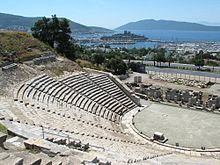BODRUM
|
History |
Halicarnassus (Ancient Greek: Halikarnassós or Alikarnassós; Turkish: Halikarnas) was an ancient Greek city at the site of modern Bodrum in Turkey. Halicarnassus were founded by Dorian Greeks, and the figures on its coins, such as the head of Medusa, Athena or Poseidon, or the trident, support the statement that the mother cities were Troezen and Argos.[5] The inhabitants appear to have accepted Anthes, a son of Poseidon, as their legendary founder, as mentioned by Strabo, and were proud of the title of Antheadae. The Carian name for
Halicarnassus has been tentatively identified with Alosδkarnosδ in inscriptions.  Theatre of Halicarnassus in Bodrum, with the Bodrum Castle seen in the background. |
Mausolus |
 Surviving substructures and ruins of the Mausoleum of Mausolus, one of the Seven Wonders of the Ancient World, in Halicarnassus. |
| Petronium |
 The Castle of St. Peter was built by the Knights Hospitaller. |
| Notable People |
|
| http://en.wikipedia.org/wiki/Bodrum |
| |
|



